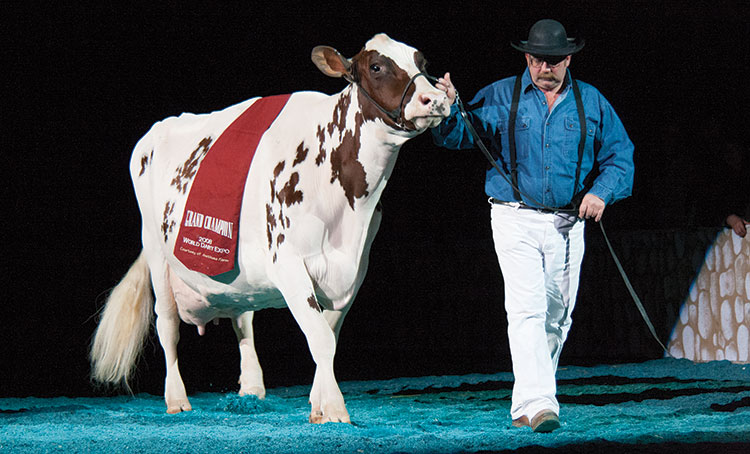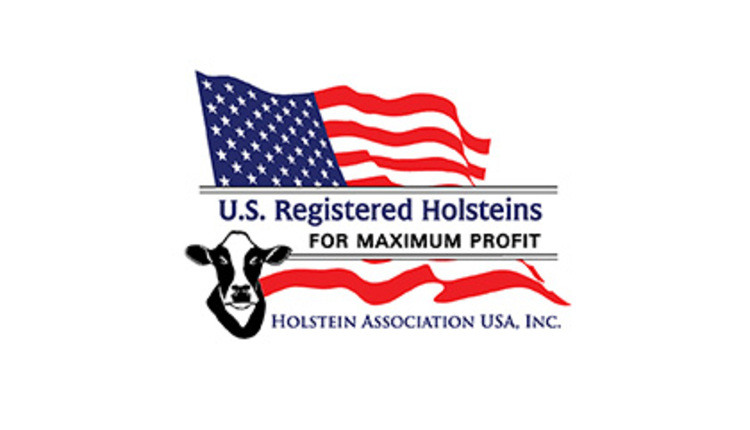
Cows are the stars of the show today, but bulls once shared the World Dairy Expo spotlight. In fact, the bull show was filled with just as much anticipation and pageantry as the cow classes. Over time, though, growth of the A.I. industry, along with safety concerns for exhibitors and attendees, led to the sunset of bull classes, starting with the Jerseys in 1977.
While the last bull show to be held on the colored shavings took place in 2009 in the Brown Swiss breed, influential sires are still recognized with the presentation of the Premier Sire award at the completion of each breed show. The sires that have won the most Premier Sire banners for each breed are listed in the table.
The most decorated sire
No bull has won Premier Sire at World Dairy Expo more times than Blackaddar Bb Kellogg of the Ayrshire breed. Kellogg captured his first award in 1999 and then went on to earn those honors every year from 2001 to 2012 for a total of 13 wins.
Kellogg’s breeder, Norman Boswall of Blackaddar Farm, Frenchfort, Prince Edward Island, felt that Kellogg had potential to become a great sire as a young calf, but he was quick to recognize that “A lot of animals have potential, but few achieve it.”
The bull came from a strong maternal line, as he was a son of Blackaddar Milky Model from the well-known Milkmaid family. Boswell said that Kellogg had a lot of milk behind him, and then his dam was bred to a type sire, Bontime Brae Kellogg. “You never know what you are going to get when you do that,” he explained.
The result, though, was certainly positive. “As soon as his offspring started coming, they started winning. And they still win,” Boswell said. “People still like to use him.”
Boswell felt that Kellogg’s popularity grew because he made cows that were dairy and tall, with great feet, legs, and udder. Once they matured, they were also great producers.
Fellow Ayrshire breeder Steve Searles from Stillmore Cattle Company of Pine Island, Minn., agreed. “Kellogg sired a lot of longevity. With great udders, the cows lasted a long time, and they milked, too,” he said.
Searles also pointed out that Kellogg remained popular for so long because he was a great type bull. “When he came out, he started siring some really great type animals,” he said. One of those cows, Valevue BBK Minerva, was owned by Searles. She was Grand Champion at World Dairy Expo in 2005, 2006, and 2008.
Kellogg was never sold through an A.I. company; instead, his semen was marketed through private sales. When he was just a calf, Bruce Mode of Bonnie Brae Holsteins, Vankleek Hill, Ontario, bought part interest in the bull, and that’s where he was housed for many years.
The Boswell family is no longer milking cows, but their herd certainly left an impact on the Ayrshire breed. “To breed a great bull, it makes you feel good,” Boswell said, quickly crediting the long line of good genetics behind Kellogg for his reign. “A great cow family, that is the key to any success.”

Like father, like son
Most Brown Swiss enthusiasts are likely familiar with a cow named Idyl Wild Improver Jinx. Bred by the Weber family of Idle Wild Farm, she was sold as a calf for a 4-H project. After winning the Western National Show as a 2-year-old, she was purchased by Peter Vanderham of Bridgeview Farm. Vanderham later consigned her to a sale, where she was purchased by Darrell Worden of Forest Lawn Farm, LLC, in Wausau, Wis. Jinx was the Grand Champion Brown Swiss at World Dairy Expo in 1985.
Working with Brian Garrison, a sire analyst for NOBA at the time, the decision was made to flush Jinx to Top Acres Elegant Simon. A few bull calves resulted, but one of them, Forest Lawn Simon Jetway-ET, stood out. “It took Brian about a second to decide which one he wanted (to buy),” said Worden.
He believes the Jetway daughters excelled because of their angularity and dairyness. “His daughters had the will to milk,” he shared.
Roger Neitzel, long-time employee of the Brown Swiss Association, echoed those thoughts. “Jetway made them more dairy, which is what the breed was starting to look for,” he said. “He also threw animals with type. It was the right combination and complement to the cows we had at that time.”
Jetway’s reign as Premier Sire lasted a decade before coming to an end in 2006, but you will still find him prominent in many pedigrees. “He’s still stamping out good ones,” Worden explained.
And even when Jetway’s run as Premier Sire ended, his presence was still felt in the showring. His son, Top Acres Jet Pilot-ET, was named Premier Sire three times between 2007 and 2011.
Cut from the same cloth
Tall and long. Black and silky. Great feet and legs. The past few years, nearly every animal left standing at the center of the ring when the Grand Champion Holstein at World Dairy Expo was named fit this description. Those cows are the offspring of a sire named Braedale Goldwyn, whose daughters have dominated the World Dairy Expo showring in recent years.
Goldwyn was Premier Sire of the Holstein Show from 2008 to 2014. From 2008 to 2011, the Junior Champion was a Goldwyn daughter. Later on, his presence was felt in the cow show. So much so that the Grand and Reserve Grand Champion cow in 2012, 2013, 2014, and 2015 were all Goldwyns.
This exceptional sire got his start without much fanfare. “It was just a planned mating,” said Goldwyn’s breeder, Terry Beaton. Beaton, along with his brother Mark and son Brent, operate Braedale Holsteins of Cumberland, Ontario. Goldwyn was a Shoremar James son born from a cow named Braedale Baler Twine.
Although Goldwyn certainly dominated at shows, Holstein USA’s Executive Director of Holstein Genetic Services Lindsey Worden explained that he was not necessarily bred for the showring and was used by all types of breeders early on.
She pointed out that Goldwyn was a high TPI sire when he came out, which is one reason he was so widely used. Goldwyn also followed behind the very popular bull O-Bee Manfred Justice-ET, or O-Man, a bull that “did a lot of great things for the breed,” according to Worden.
Then Goldwyn came along with a really nice type profile. He also had great udder traits, low somatic cell count numbers, and was positive for production and fertility. “He had a lot of things the breed was looking for,” Worden said. “That is how he got his start.”
Once his milking daughters started winning at shows, “That really cemented his legacy,” she said. “The proof is in the pudding in his milking daughters.” Worden added, “Every generation, certain bulls come along that fit our need. Goldwyn did that for his time.”
Goldwyn’s widespread popularity has been exciting for the Beaton family. “That cow family did well for us,” Beaton said. “It’s great to see our prefix go around the world.”
Goldwyn, Jetway, and Kellogg, along with the top sires from the other breeds, have certainly left their mark on World Dairy Expo. Even further, they have made an impact on show strings around the world and in barns across the globe.
It takes strong cow families, smart mating, and a little luck to create these top bulls. But, when the pieces come together just right, a sire can stand the test of time and make some of the best cows in each breed.










